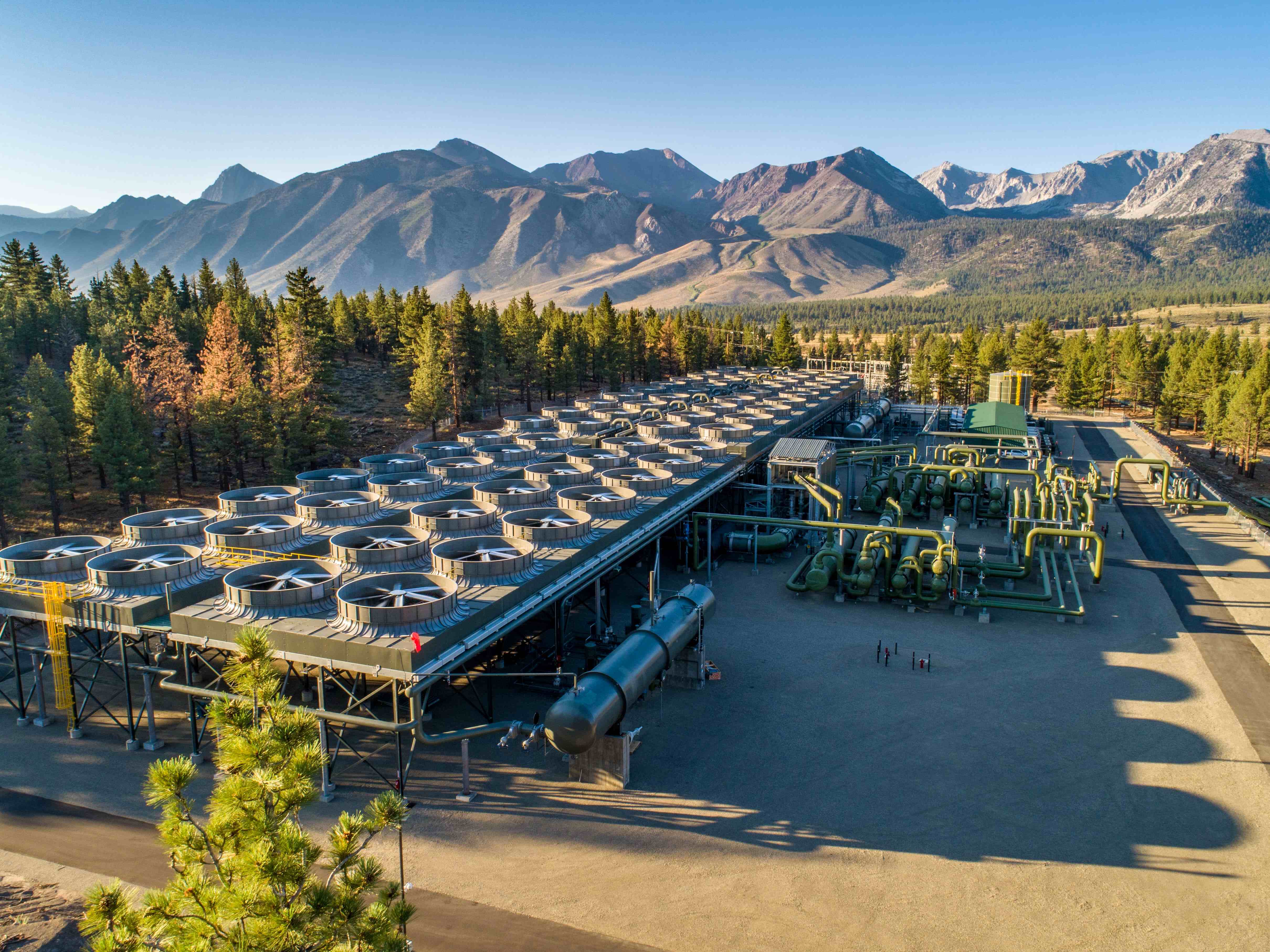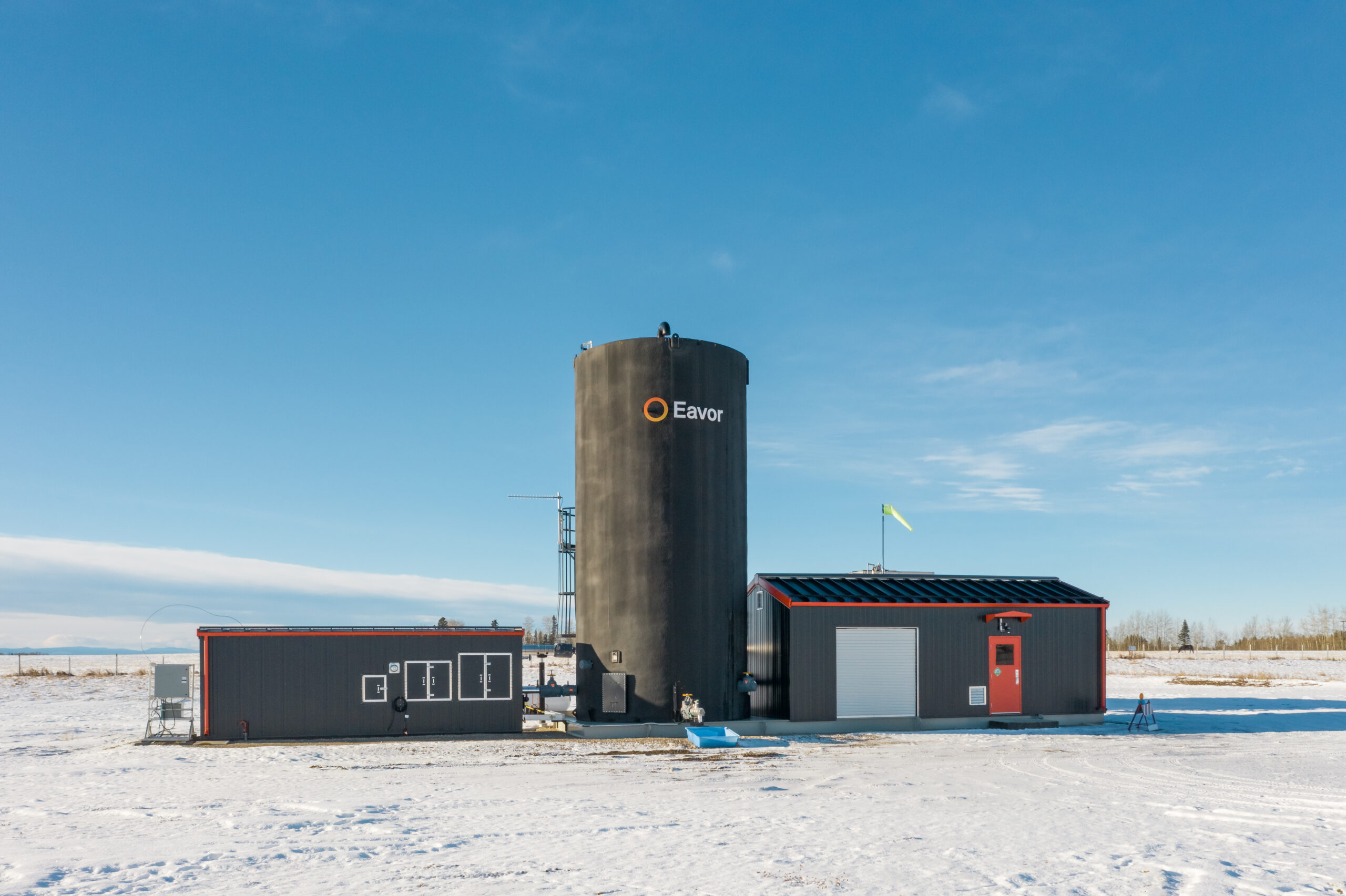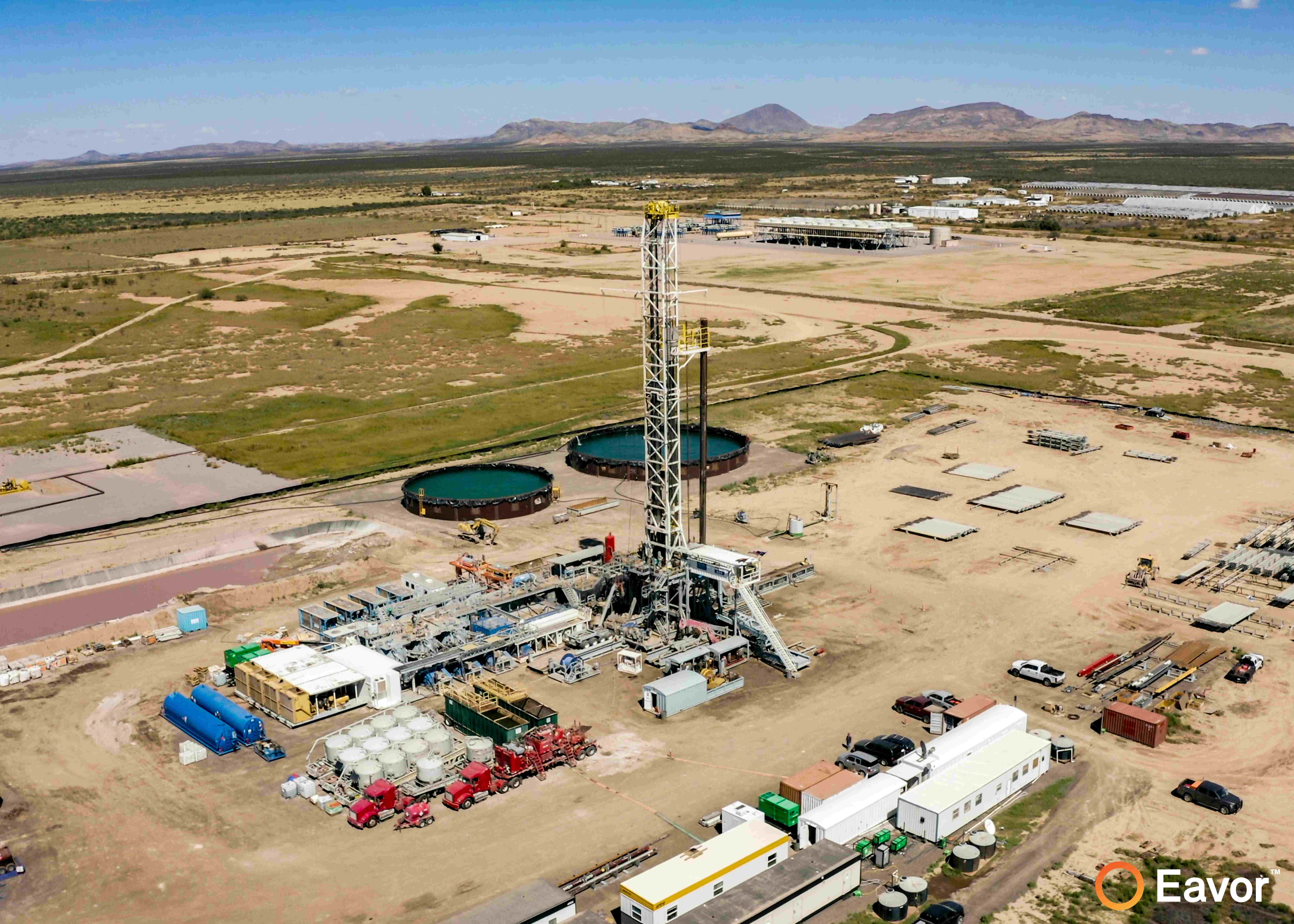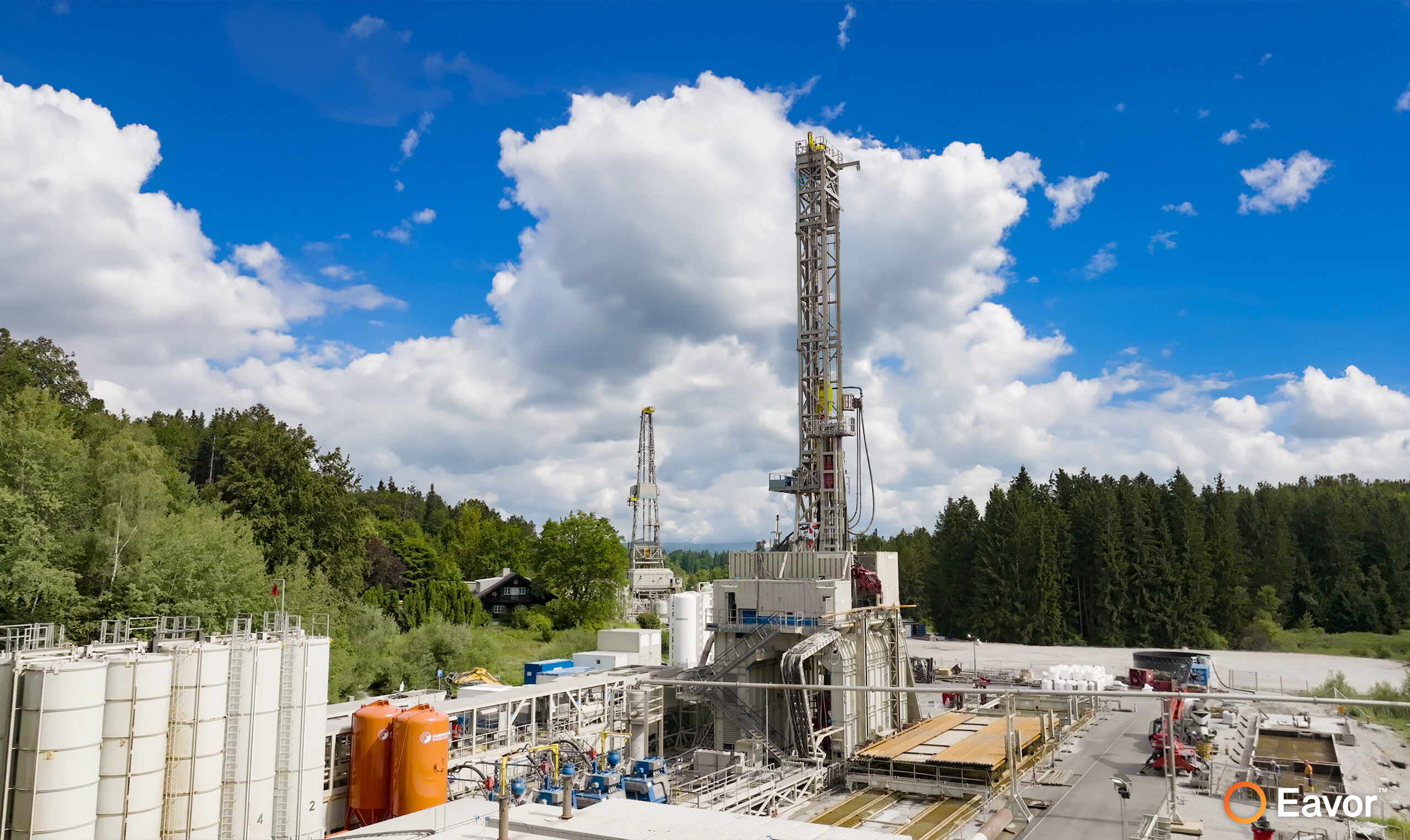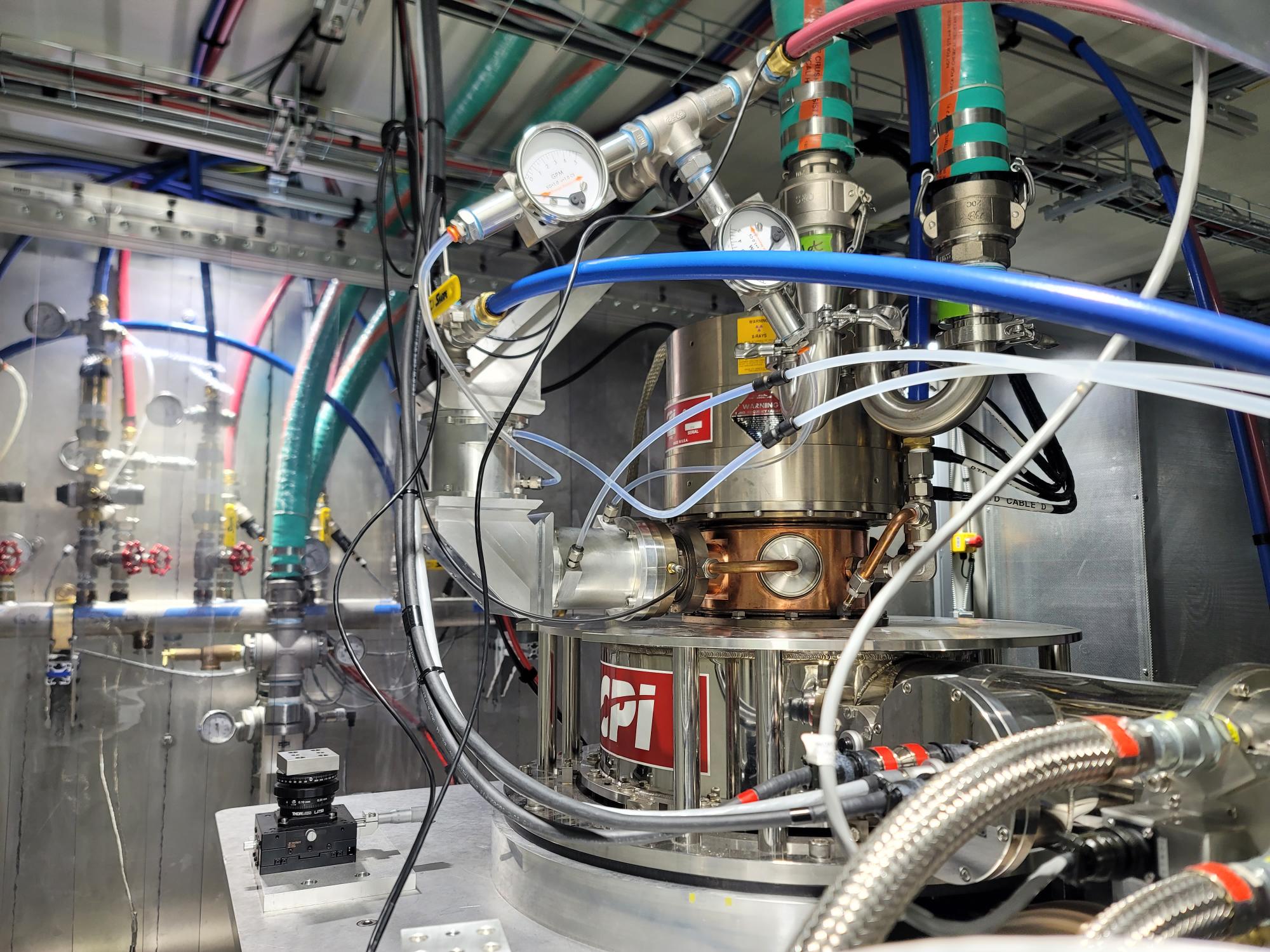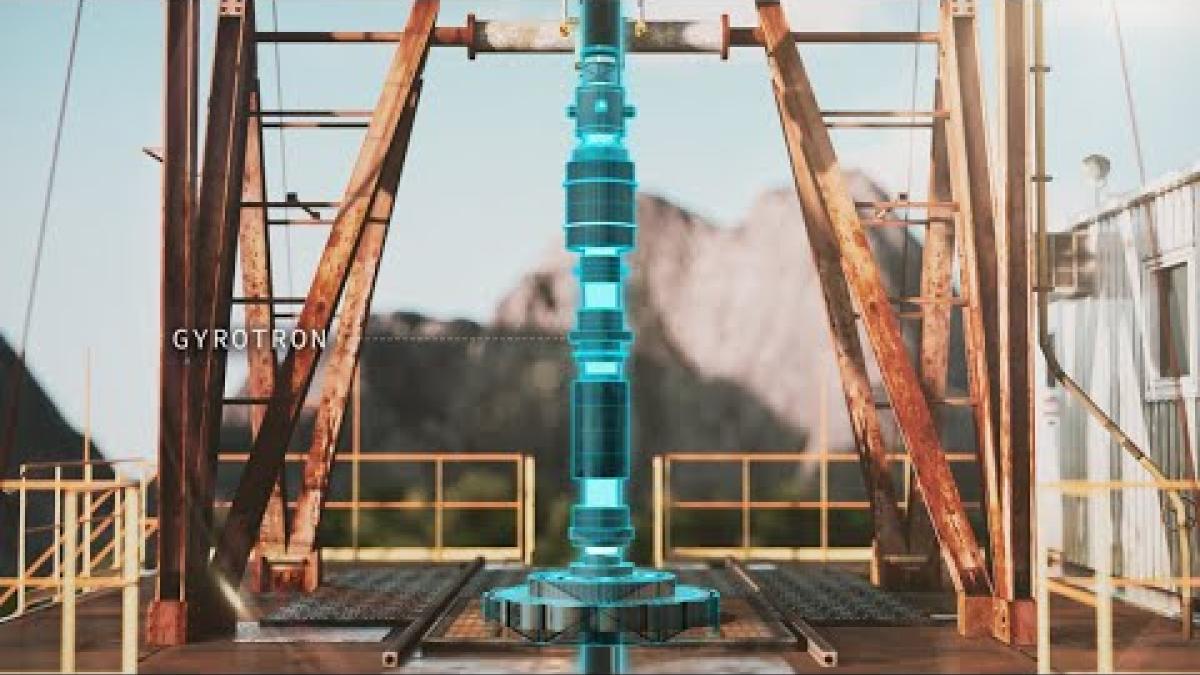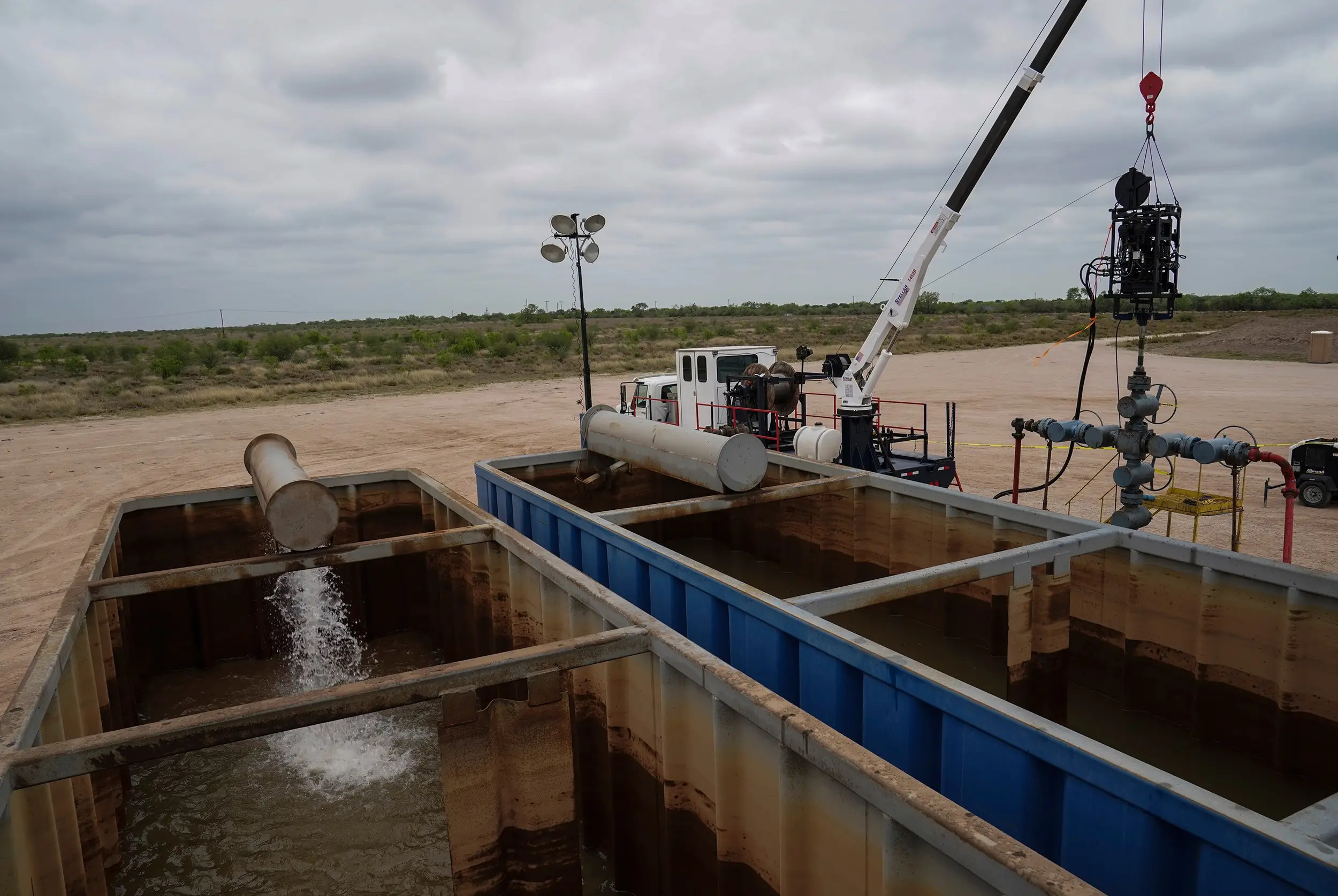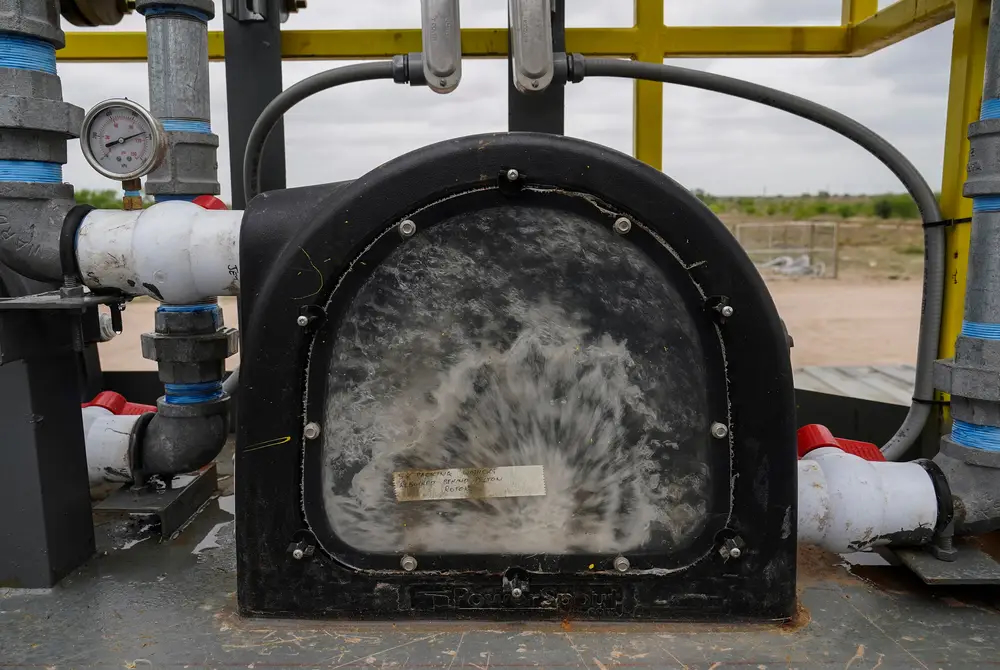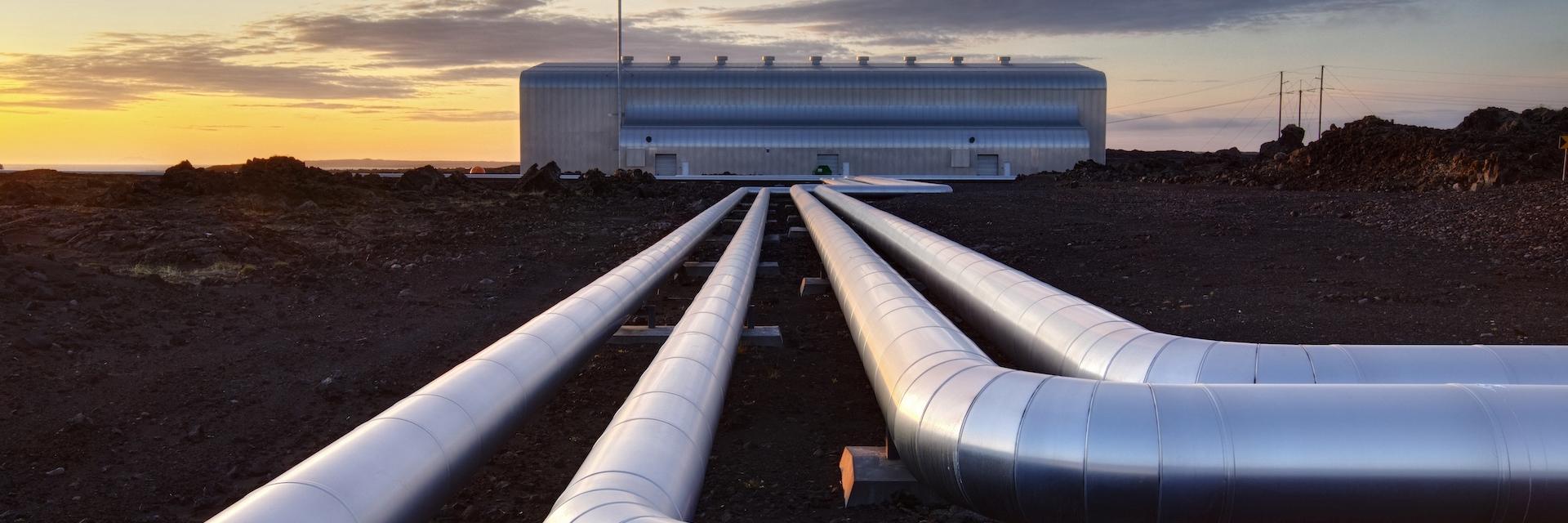
View of pipework and Geothermal power plant, Reykjanesvirkjun, South West Iceland.
Credit: Guy Edwardes / Nature Picture LibraryGeothermal
Expand the use of geothermal energy as a global source for heating, cooling, and electricity.
Geothermal is a nearly unlimited source of renewable energy. It is the heat left over from the formation of the Earth and the decay of radioactive materials within the Earth’s core. This heat can be tapped as a form of baseload energy without interruption, unlike wind or solar power. Geothermal can directly heat buildings, warm and cool with heat pumps, or can be used to power turbines with steam, generating electricity. Geothermal plants and technologies produce minimal greenhouse gas emissions. Despite these benefits, geothermal currently supplies under 1 percent of global energy. This is changing, however, as technological advancements accelerate its potential for wider use. Further research, as well as expanded investment in proven systems, are essential to ensure that geothermal is successfully scaled up as a major source of energy worldwide.
Action Items
Individuals
Learn about the benefits and potential of geothermal energy. Geothermal energy has been tapped by many cultures for millennia in places where heat and steam are found close to the earth's surface. Iceland heats 90 percent of its homes and buildings with geothermal. Other active locations include the western United States and the Pacific Ring of Fire. Geothermal development has been limited by high initial investment risk and geological and location restrictions. Today, innovations are allowing access to deeper stores of heat as well as the utilization of lower temperatures. As a result, geothermal has the potential to be globally scaled, becoming an important resource in the clean energy transition. From large-scale power plants generating megawatts of electricity to home-size heat pumps, geothermal energy offers a wide range of potential benefits:
- Simple to harness. Direct-use geothermal, which depends upon a naturally occurring source of heated water, can be used to heat and cool buildings, towns, or cities, bypassing the need for generating electricity. Reykjavik, Iceland, has the largest direct-use geothermal system in the world, and many cities in Europe, China, and the United States are employing these systems for municipal heating and cooling. Cornell University, Finland, and Bali are all developing deeper wells for direct-use geothermal heating.
- Cost savings. Directly using geothermal energy in homes and
commercial operations can save 80 percent over fossil fuels. - Low life-cycle greenhouse gas emissions. Geothermal power plants emit 99 percent less carbon dioxide than fossil fuel–burning plants and have lower life-cycle emissions than solar.
- No batteries are required. Since geothermal is continuously available as a power source, there is no need for storage batteries, unlike solar and wind energy, which are intermittent (see Solar Nexus and Wind Nexus). The production and disposal of batteries can be environmentally damaging, which gives geothermal an advantage.
- Less space. Geothermal requires much less land and physical space to generate renewable energy than wind and solar production.
- Existing energy infrastructure can be converted to geothermal. Utilizing existing infrastructure for geothermal energy production can help transition away from fossil fuels. Abandoned power plants can be repurposed for geothermal energy production. This well-reclamation project would be the first of its kind in England.
- Technological advancements are increasing accessibility. Geological restrictions have been a limiting factor in the expansion of geothermal energy. However, recent developments in enhanced and advanced geothermal technologies, which tap into dry rock and/or very deep reservoirs of heat, potentially allow access to geothermal heat and subsequent electricity generation almost anywhere. This new wave of advancements is spurring renewed investment and interest in geothermal energy, which could be catalytic for the industry.
Install a geothermal heat pump where you live or work. Installing a heat pump is one of the best ways for individuals to take action to utilize geothermal energy. They can be up to four times more efficient than conventional heating and cooling systems, require less maintenance, and have a longer life span (see Heat Pumps Nexus).
- In the U.S., there are substantial federal tax credits to incentivize the installation and use of geothermal heat pumps.
- In Finland, the installation has increased heating by geothermal heat pumps to 15 percent of the national total.
- The main challenge to installing a geothermal heat pump is the up-front cost, but they can potentially pay for themselves within five to ten years.
Support geothermal energy initiatives in your community. Geothermal can be a key local solution. Communities can work with companies that focus on small-scale geothermal projects to create resiliency. Examples include:
- The Eden Project in the UK, created on the site of an abandoned clay mine, will run completely on geothermally generated electricity and aims to serve as a model for other projects.
- Towns are beginning to test and study geothermal heating systems for cost-effectiveness and reliability. Projects such as this one in Framingham, Massachusetts, can serve as a model for other towns and neighborhoods.
- This community in Canada is using small-scale decentralized geothermal units to support food production, heat buildings, and bolster the tourism industry.
- Two colleges in Massachusetts are replacing their fossil fuel–based heating systems with geothermal district heating.
Support advocacy organizations that promote geothermal. Connecting with organizations is a great way to hear the latest news and encourage developments from the geothermal sector (see Key Players below for more).
- Geothermal Rising is an organization whose mission is to connect the geothermal community and champion geothermal energy.
- The Global Geothermal Alliance is a coalition to increase the use of geothermal energy, both in power generation and direct use of heat.
- IGA (International Geothermal Association) works for the acceleration of geothermal applications through events such as the World Geothermal Association and the Geothermal Accelerator.
- The Philadelphia-based advocacy group Geodelphia can serve as an inspirational model for forming an advocacy group in your community.
- The latest news about new developments in the geothermal sector can be found here.
Groups
Architects and Builders
Design and build new developments that use geothermal energy. As the demand and need for low-emissions construction continue to grow, utilizing geothermal heating and cooling in new construction can be cost-effective and profitable.
- Homes and buildings with geothermal heating and cooling systems offer the prospect of saving money on utility costs to potential clients.
- This project in Germany is tapping shallow (60 feet) thermal heat for a residential development.
- Developers are including geothermal heating and cooling to a 7,500-home project in Texas and another in Oklahoma.
- This project in Georgia is the first development in the U.S. to be fully heated and cooled by geothermal energy.
Companies
Geothermal Companies
Continue developing technologies to make geothermal more affordable and accessible. Work is needed to increase access to geothermal energy, develop new projects with existing technology, and reduce risk. Examples include:
- Quaise has been developing a new drilling technique that uses high-power millimeter waves to harness deeper stores of heat. This innovation has the potential to bring geothermal energy to places where access has typically been impossible.
- Fervo Energy is deploying existing technology from oil and gas drilling and is developing new technologies to reduce the risks involved with geothermal well exploration and implementation.
- Here is a brief overview of some of the European geothermal companies working to transition Europe away from its reliance on natural gas.
- Eavor and GreenFire are leading the industry in developing closed-loop systems with higher efficiency and less waste.
- Up to half of the energy produced in traditional power plants is lost as heat. The Swedish company Climeon has developed low-temperature technology that uses waste heat to optimize energy production.
- DeepPower has partnered with the University of Oklahoma to explore how its deep-drilling geothermal technology can be expanded to access new sources of geothermal energy.
- With its MiniGeo system, Dutch company IF Technology is working with Indonesia to bring geothermal power to remote locations.
- Advanced geothermal plants hold the potential to work in conjunction with solar and wind generation, each helping the other to optimize their potential and become more efficient.
Work with oil and gas companies to continue to shift resources into the research, development, and implementation of geothermal projects. Some of the biggest players in geothermal are oil companies, which already have access to financial resources, drilling technologies, and equipment infrastructure. Examples include:
- Gradient Geothermal (formerly Transitional Energy) partnered with Grant Canyon Oil & Gas to successfully generate geothermal energy from an old oil well.
- The European conglomerate OMV is using some of its existing infrastructure and expertise to develop geothermal in its transition to a lower-carbon business model.
- Eavor, which employs a closed-loop system with no fracking, external contaminants, or waste, received investments from BP and Chevron.
- Oil and gas companies can reduce waste by harnessing the heat generated from traditional drilling.
Utility Companies
Invest in geothermal. Utilities can continue to work with geothermal energy companies to develop and deliver electricity from geothermal sources to their customers and continue to offer consumers “green pricing” options. By choosing renewable energy sources, consumer demand can directly influence the development of renewable energy, including geothermal.
- The Clean Power Alliance recently partnered with Fervo Energy to deliver electricity generated from geothermal to over thirteen thousand homes in Southern California.
- New Zealand’s Contact Energy is investing NZ$300 million to build a geothermal power plant that will single-handedly increase the country's renewable energy generation by 5 percent per year.
Governance
Implement legislation to support geothermal. In order for geothermal energy to become widespread, governments need to work cooperatively with the businesses and industries that are ready to develop new geothermal energy. Areas of support include:
- Mitigating the initial risk of geothermal exploration. The most significant obstacle to more widespread geothermal application is the risk of losing initial investments to failed well exploration. Indonesia has taken steps toward mitigating those risks by partially covering the costs of any failures.
- Streamlining the permitting process for geothermal projects. From the federal level to the local level, governments can responsibly offer easier access to geothermal exploration and development. Kenya is a leading force for geothermal in Eastern Africa and is an example of a government working to create conducive policies for geothermal development.
- Creating incentives for geothermal generation and new plant construction. The state of Nevada issued a $12.6 million tax incentive for the construction of a new geothermal plant that will be sold to Southern California’s electricity market.
- Continuing to create and offer credits so that individuals and businesses are incentivized to convert homes and buildings to geothermal heating and cooling, such as heat pump credits.
Commit to research and development of geothermal energy. Governments can lead the way for businesses and investors to feel confident in the future of geothermal.
- FORGE is one of the leading enhanced geothermal projects in the world, sponsored by the Department of Energy (DOE) in the United States.
- The U.S. DOEnergy is supporting new research and development in geothermal with the goal of cutting the cost of geothermal energy by 90 percent by 2035.
- Cooperation between governments, such as between the U.S. and New Zealand, can accelerate the availability of advanced, cost-effective geothermal technologies worldwide.
Invest in expanding geothermal production. Governments can play a role in accelerating geothermal energy by investing or facilitating private investment.
- Five municipal governments around the world are implementing citywide heating and cooling solutions using geothermal.
- The UK and Scotland established the Net Zero Technology Center, which awarded over $10 million to Cera Phi Energy to develop geothermal.
- The European Union is aiming for a 58 percent increase in geothermal energy production by 2050 with this spending initiative.
- Innovation awards, such as the Ruggero Bertani European Geothermal Innovation Award, create incentives and support for technological development.
- Here is an initiative funded by the U.S. government to explore abandoned gas wells to convert to geothermal.
- Indonesia is a world leader in geothermal production, striving to make use of its high levels of volcanic activity. Government policy actively encourages geothermal investment and development.
- Federal governments can invest in Indigenous-owned geothermal projects that benefit First Nation communities, such as the Tu Deh-Kah initiative in Canada.
Train people for jobs in the geothermal sector. In conjunction with spending on geothermal development, governments can begin to prepare a skilled workforce.
- Iceland has teamed up with UNESCO to pioneer a Geothermal Training Program that aims to assist developing countries in exploring and developing geothermal.
- Kenya, the UN, and Iceland have created the Geothermal Center for Excellence in Kenya to help develop skilled geothermal workers in Africa.
- With oil- and gas-sector jobs declining steadily and reskilling initiatives underway, there is a pool of potential geothermal workers, from manual laborers to engineers.
Key Players
Projects and Companies
Utah FORGE (Utah) is a dedicated underground field laboratory sponsored by the Department of Energy (DOE) for developing, testing, and accelerating breakthroughs in Enhanced Geothermal Systems technologies to advance the uptake of geothermal resources around the world.
Eavor (Canada) is a Next Generation Geothermal technology-based energy company led by a team dedicated to creating a clean, reliable, and affordable energy future on a global scale.
Fervo Energy (Texas) leverages innovation in geoscience to accelerate the clean energy transition by providing cost-effective, reliable geothermal energy.
Quaise (Massachusetts) has an approach to geothermal energy that uses the established workforce, assets, supply chains, and regulatory frameworks of the fossil fuel industry instead of creating infrastructure from scratch.
Sage Geosystems (Texas) is a game-changing company that makes geothermal energy available and affordable everywhere by not only harvesting heat but also pressure in a well using proven oilfield technology to cut costs.
Ormat Technologies (Nevada) wants to become a leading global provider of renewable energy, while building a geographically balanced portfolio of geothermal, recovered energy and storage assets.
Toshiba International Corporation (Japan) is stepping forward globally to help conserve fossil fuels and contribute to the diversity of energy sources with advanced geothermal energy systems.
First Gen (Philippines) has created the world’s largest vertically-integrated geothermal company (Energy Development Corporation), engaged in the exploration, development, operation, and optimization of geothermal steamfields, and in power generation.
Mitsubishi (Japan) has invested in multiple geothermal energy projects.
EthosEnergy (Texas) leads the way in delivering innovative solutions for geothermal power plants, tackling safety and reliability challenges head-on.
Chevron (California) is collaborating with MOECO on advanced geothermal technology.
AltaRock Energy (Washington) is a technology leader in Enhanced Geothermal Systems (EGS) development. It is raising EGS to a massive scale, making clean, affordable, renewable geothermal energy available anywhere and everywhere.
Dandelion Energy (New York) creates high-performance, earth-powered geothermal heating and cooling systems.
Eden Geothermal (Cornwall, UK) is a partner on a groundbreaking geothermal energy project onsite which provides heat to their Rainforest and Mediterranean Biomes and brand new state-of-the-art plant nursery.
Gradient Geothermal (Colorado) offers a comprehensive solution for oil and gas operators looking to optimize their energy use and reduce their carbon footprint with geothermal systems.
Renew Systems (Global) is developing next-generation geothermal power plants to accelerate the clean energy transition.
Organizations
Geothermal Rising (U.S.) connects the geothermal community and champions geothermal energy in the United States and around the world.
Global Geothermal Alliance (UAE) serves as a platform for dialogue, cooperation and coordinated action between the geothermal industry, policy makers and stakeholders worldwide.
International Geothermal Association (Netherlands) is a global organization supporting the geothermal sector
and delivering the future of clean energy.
Institute of the Americas (U.S.) has promoted sound public policy and fostered cooperation between public and private sector stakeholders across the hemisphere for 40+ years.
ThinkGeoEnergy (Iceland) is the leading information services provider for the global geothermal energy sector and the market it serves.
EGEC: The Voice of Geothermal in Europe (Belgium) is a not-for-profit organisation promoting all aspects of the geothermal industry.
Project Innerspace (U.S.) is the leading independent organization dedicated to rapid global development of geothermal energy.
Geothermal Canada is a not-for-profit organization committed to advancing science and promoting geothermal research and development in Canada.
Canadian Geothermal Energy Association has a mission is to accelerate Canadian exploration and development of geothermal resources in order to provide secure, clean, and sustainable energy.
Government Organizations
ARPA-E (Washington, D.C.) advances high-potential, high-impact energy technologies that are too early for private-sector investment.
Learn
Watch
Geothermal Energy Is Renewable and Powerful. Why is Most of it Untapped? by DW Planet A (10 mins.)
This Overlooked Energy Source Could Supply 50% of All Electricity by CNBC (16 mins.)
How a Geothermal Breakthrough Could Transform Our Energy Grid by Grist (9 mins.)
Geothermal Will Change Our World... by Eavor (12 mins.)
Advances and Challenges in Enhanced Geothermal Systems: Nondestructive Tools to Understand Subsurface by Wisconsin Energy Intitute (62 mins.)
East Africa’s Geothermal Green Energy Revolution by euronews (5 mins.)
Why This Fusion Tech May Be a Geothermal Energy Breakthrough by Undecided with Matt Ferrell (18 mins.)
Geothermal Discovery Could Launch Green Revolution for Energy Industry by CBC News: The National (9 mins.)
Why Geothermal Energy Is Being Viewed as a Viable Alternative to Fossil Fuels by PBS NewsHour (9 mins.)
Deep Geothermal Energy at the Eden Project in Cornwall by Eden Geothermal (5 mins.)
Batteries Are Dirty. Geothermal Power Can Help by Vox (8 mins.)
Affordable Geothermal by This Future House (13 mins.)
Read
"How Long Could the World Run on Geothermal Power?" by Rhett Allain / Wired
Geo Power: Stay Warm, Keep Cool, and Save Money with Geothermal Heating and Cooling by Donal Blaise Lloyd / PixyJack Press
Geothermal Energy Systems by Ibrahim Dincer and Murat Ozturk / Elsevier
Geothermal Power is a Climate Moon Shot Beneath Our Feet by Brent Crane/ The New Yorker
Listen
The Forgotten Renewable: Geothermal Energy Production Heats Up by NPR (3 mins.)
The Future of Geothermal Part 1: Technology Department (30 mins. and Part 2: The Business Case (31 mins.) by the Switched On Podcast / Bloomberg News
Geothermal Energy - The Basics by the Planet Geo Podcast (34 mins.)
Geothermal Energy by the Everything Everywhere Daily Podcast (11 mins.)
Geothermal Is the Future of Energy - John Redfern, CEO Eavor by the Switch Podcast (47 mins.)
Biden’s Big Geothermal Bet by Politico Energy (7 mins.)
The Extraordinary Potential Value of Enhanced Geothermal Power by Volts Podcast (65 mins.)
Share this page




